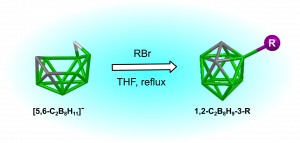Contact person: Bohumír Grüner
Current focus is devoted mainly to chemistry of ten-vertex dicarbaboranes. This chemistry is essentially derived from that of the nido-5,6-C2B8H12 dicarbaborane, the most significant compound of the 10-vertex dicarbaborane series. This carborane along with its derivatives gave rise to all the three closo-C2B8H10 isomers and to arachno-6,9-C2B8H14 that serve as potential substrates for various reactions, which pathways often dramatically influenced by substitution. Insertion of skeletal carbon atoms provided, depending on the starting compound, either tricarbollides or methylated 10-vertex derivatives. Closure of substituted and unsubstituted nido-cages by dehydrogenation provides isomeric 10-vertex closo-carborane systems. Alkylation and halogenation and in the area of 10-vertex dicarbaborane skeletons have been studied in details with the aim of constructing new molecular shapes that contain organized globular molecules arranged according to the planned design. Also the impact of the alkyl substituent on cage closure reactions and isomerisation pathways was inspected, often with surprising results. A representative series of new molecules in which carborane core is protected by an organic sheath has been generated by targeted methylation. Individual chemical transformations are studied within the context of explanation of possible reaction mechanisms and consequences in NMR spectra. Recent developments in 10-vertex cage chemistry resulted in the isolation of the wide series of new compounds that may now start playing ever increasing role as building blocks, in material science, biomedicinal applications, etc.
Chemistry of main group metal heterocyles. This chemistry is focused on the synthesis of the new family of heterohelicenes built from fused siloles with up to 20-30 condensed heterocycles, the longest helicene known so far. We are expecting to obtain new types of saturated and unsaturated (poly)heterocyclic compounds containing B, Si, Ge, Sn, O, S, and N in various combinations. These compounds are potentially useful for molecular electronic, capacitors and Si-C composites.
References
Bakardjiev, M.; Holub, J.; Machacek, J.; Hnyk, D.; Stibr, B.; Ruzickova, Z.; Ruzicka, A. Angew. Chem.-Int. Ed. 2015, 54, 4937-4940.
Bakardjiev, M.; Stibr, B.; Holub, J.; Tok, O. L.; Svec, P.; Ruzickova, Z.; Ruzicka, A. Inorg. Chem. 2016, 55, 7068-7074.
Stibr, B.; Holub, J.; Bakardjiev, M.; Lane, P. D.; McKee, M. L.; Wann, D. A.; Hnyk, D. Inorg. Chem. 2017, 56, 852-860.
Stibr, B.; Tok, O. L.; Holub, J. Inorg. Chem. 2017, 56, 8334-8340.
Bakardjiev, M.; Tok, O. L.; Ruzicka, A.; Ruzickova, Z.; Holub, J.; Hnyk, D.; Fanfrlik, J.; Stibr, B. RSC Adv. 2018, 8, 38238-38244.
Tok, O. L., Lang, K., Růžička, A., Cvačka, J. Angew. Chem.-Int. Ed. 2019, 58, 1654-1658.



